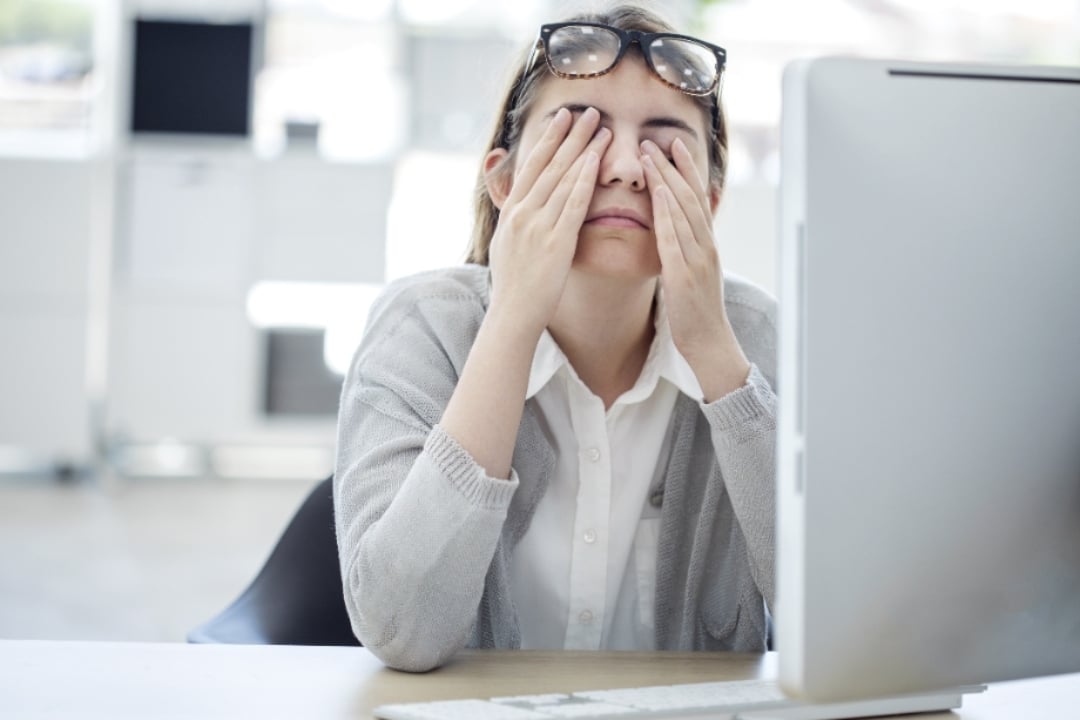Dealing with Digital Eye Strain
Even during more normal times, Americans tend to spend a lot of time looking at digital screens.
However, these are not normal times. And for many reasons, you might start to notice that the amount of eye strain you experience has increased, perhaps significantly, now that you’re spending a lot more time than usual at home due to the COVID-19 stay-at-home order.
It could be that you’re simply spending more time looking at screens, whether that’s due to changes in your work responsibilities or simply having a lot more downtime to fill. But it could also be that changes in your environment have made using a computer or phone simply tougher on your eyes than normal.
If you’ve noticed an increase in eye strain recently, don’t ignore it. Persistent eye strain can not only irritate your eyes, but also cause headaches, neck and shoulder aches, and more.
Fortunately, even if you have a job that requires you to be at a computer for a large percentage of the day, there are still many steps you can take to help reduce the amount of pain and strain that your eyes experience. Here are some of the most important tips.

Adjust the Display Settings
Not all screens are equally hard on your eyes—it depends on what’s being displayed, and how. Some attributes of a display that are closely linked to eye strain include:
- Brightness. Most people’s screens are too bright, but if your screen is too dark, that can also cause you to squint and strain, too. A good way to find the sweet spot is to open up a webpage or image with a mostly white background. If your device looks like a light source, it’s too bright. But it should still be clear—not dull and gray.
- Color temperature. Colors with shorter wavelengths (blues especially) tend to produce more eye strain than colors with longer wavelengths (like red and orange). If your work does not require you to use a display with perfect color accuracy, try shifting the color balance more toward the red side of the spectrum.
Most computers and monitors will allow you to adjust brightness and color temperature (or tint) easily via the digital display setting, or physical buttons on the monitor. For a mobile device, you may need to download a blue light filter from your device’s app store.
Adjust the Lighting in the Room
It isn’t just the lighting of the device that can contribute to eye strain. The lighting in the room—both how bright it is, and where it’s positioned—can have a noticeable effect.
You want to avoid excessively harsh lighting, whether that’s coming from the sunlight outside or bright indoor lighting. Of course, looking at a bright screen in a pitch black room isn’t much better.
Again, the key is finding the right balance. Ideally you want the lighting to be somewhat dim (a little less bright than you’d typically find in an office setting) and coming from behind (and not directly above) you.
You might find your eyes feel better if you turn off the overhead light in the room and position a floor lamp behind you. Also, avoid sitting directly in front of or behind a window if you can—but at the very least, make sure that window has good blinds so you can adjust the amount of light reaching your eyes.
Improve Your Posture and Positioning
Poor posture can definitely contribute to eye strain. If your workstation is set up properly, you can not only ease the discomfort on your eyes, but on your neck, shoulders, and back as well.
You should be able to use your computer comfortably while sitting in a neutral, comfortable position for your back and neck.
Here are a few key things to think about.
- Screen distance. For a typical computer or monitor, you want the display to be around 20-24 inches from your eyes for comfortable focusing—or about an arm’s length for most people. However, you may have to sit a little further back if the screen is particularly large.
- Screen height. In order to avoid strain on your eyes and neck, elevate your screen so that your eyes, when looking straight ahead in a neutral head position, are lined up with the top third of the display, and only looking slightly downward (10-15 degrees) to the center of the screen. You may need to raise your display by setting it on a platform (or even a pile of thick, heavy books.)
In regard to screen height, if your display is a laptop, you may need to use an external keyboard or mouse so you can continue to operate your computer with both your eyes and your hands in a comfortable position.
If you wear bifocals, you will want to keep the screen lower so that you do not have to maintain a “chin up” position
to see the screen clearly. If you still can’t reach a comfortable position, a pair of computer glasses set for the distance between your desktop computer and your eyes may be helpful.

Take Frequent Breaks
It’s extremely important to take regular eye breaks throughout the day, as too much intense focus for too long is a major contributor to eye strain.
One common suggestion is the so called “20-20-20 rule.” What this means is that, about every 20 minutes, you should look away from your computer and focus your eyes on something at least 20 feet away, for at least 20 seconds.
That’s a good starting point, but we’d also recommend that you get up from your desk, walk around, and do something different for at least a couple of minutes every 1-2 hours throughout the day.
If you get a lunch break, don’t just bury your head in another screen, or even work on something else that requires close focus (such as reading a book). It’ll be much better for your eyes to go outside for a bit, or look at things that are further away from you.
Keep Your Eyes Moist
Eye strain tends to be worse if the surrounding air is extremely dry, or if you’re near a vent or fan and air is circulating near your face. Furthermore, some studies have shown that people using screens blink significantly less often than normal, which also contributes to eye dryness.
Some “environmental” solutions that can help are turning off or repositioning fans, turning down the furnace, moving to a different part of the house, or using a humidifier in your home office. You can also consider using eye drops if your eyes are starting to feel dry and tired. For more tips, check out our recent blog.
Limit Screen Use During Your Free Time
We know—phones, TV, and other screen-based entertainment options can be addicting. But if you’re already in front of a computer most of the day for work, try to limit recreational screen time so your eyes can do something else for most of the evening.
We’re not saying you can never settle down and enjoy a show on Netflix! Just be intentional about making time for other kinds of leisure activities—go for a walk, ride your bike, read a book, do a puzzle, etc.
Consider Upgrading Your Display
Newer and more expensive isn’t necessarily better when it comes to monitors, but there are some “minimum standards” when it comes to displays that can help reduce your strain. If you’ve already tried the above tips and are still having significant problems with eye strain, replacing the display could be the next step.
First, if you’re still using an old-style CRT monitor, consider replacing it with a digital flat-screen display. With CRTs, the image “flickers” and dims while the image is being refreshed, which can contribute to eye strain. If you’re stuck with a CRT monitor for your computer, check the display settings and make sure the screen refresh rate is set as high as it will go. This will make the flicker less noticeable.
One other thing you may consider is whether your screen has a “glossy” vs “matte/anti-glare” surface. While glossy screens often appear clearer and more vivid, they also reflect a lot of glare and light directly back into your eyes. A matte finish may look slightly “fuzzier” or less vibrant, but the tradeoff is a lot less glare, and potentially less eye strain.
Not sure which type you have? Try using your screen in direct sunlight, or right in front of a bright light. If you can barely see the display, it’s glossy.
Consider Upgrading Your Corrective Lenses
If your current glasses or contacts aren’t the correct prescription anymore, that will obviously have a negative effect on your ability to focus on a display comfortably.
However, glasses can also be made with anti-reflective coating on the lenses, or have anti-reflective coating applied to an existing pair. When you apply AR coating to a lens, a greater percentage of the light that hits your glasses can actually get through to your eyes, rather than reflecting back away from you. The result is clearer and sharper vision, which in turn makes it easier to focus without strain.
In fact, some people buy non-prescription “computer glasses” with anti-reflective coating, and sometimes even color tinting. Prescription computer glasses can be helpful for some people who typically require bifocals.
While these may work for you, again, we wouldn’t recommend you go out and buy something new unless you’ve already tried the “free” options available to you earlier in this blog. Computer glasses are more of a “last resort,” since they won’t do anything to help you if your current setup already allows you to work without strain.
We’re Still Open for Urgent Care
Although minor eye aches are a normal part of life, you should always exercise caution if you are experiencing symptoms like chronic or severe eye pain, or sudden changes in vision.
Sight Eye Clinic is open even during the stay-at-home order to provide urgent care for our patients who are experiencing concerning symptoms. Call us during business hours to set up an appointment if you think you need to be seen at (616) 772-2020.
And remember, if you ever have any questions about your eye health, you can always call our office and ask. If we think your issue is something that requires an in-person visit, we will let you know and help you schedule an appointment.
In the meantime, we hope you, your family, and your eyes stay healthy and safe!
